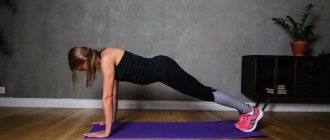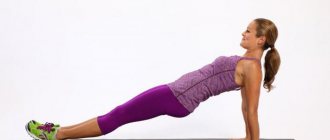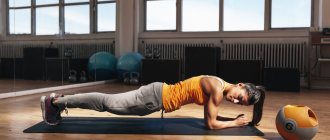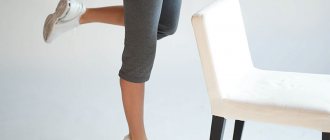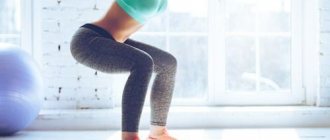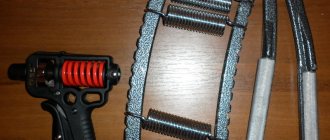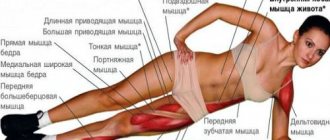The plank is a very popular fitness exercise that is used by both amateurs and professional athletes. Despite the fact that there is nothing complicated in doing it, it gives a high-quality load on the muscles and helps you lose weight. Let's try to answer the basic questions about the bar.
What is a plank
The plank is a universal isometric exercise that allows you to strengthen several muscle groups at once. It is performed statically, that is, during execution we do not move. The classic plank involves focusing on straight arms and toes. The body should be in a straight line, with the gaze directed forward. You need to stay in this position for a certain time.
There are different variations of the plank: on straight arms, on the elbows, reverse, with raising the legs and arms, side and so on. Combining them with dynamic exercises, you can achieve remarkable fat burning
Varieties of planks ↑
There are many variations of this exercise. If the standard plank uses all the muscles, then these variations place special emphasis on one specific muscle, while the rest work as usual.
Classic plank ↑
A universal exercise with which you should start getting acquainted with this stance.
You need to take the position while lying down, but this must be done not on outstretched arms, but on the elbows. The forearms are placed on the floor, and the entire weight is distributed between the toes and elbows.
Keep your back straight and tuck your pelvis a little to align your spine as much as possible. We monitor the uniformity of breathing and stand in this position for 20 seconds or more.
Plank for developing hips and buttocks ↑
Although the hips and buttocks are involved in the process of supporting the body during a classic stance, they are not heavily loaded. This situation can be corrected by adding alternating leg raises to the exercise.
While in a standard stance, we raise one leg, bent at the knee, until the thigh is parallel to the floor line. We put the leg back and do the same with the opposite leg. Repeat 12 times for each leg.
Twist plank ↑
If you dream of a slimmer waist, then you should focus your attention on exercises for the oblique abdominal muscles. This type of plank is one of them.
We need to take a position in which the body weight will rest on one arm, for example, the left one, bent at the elbow and left leg. The right palm is placed on the back of the head, and the right leg is placed on top of the left.
We turn our body, trying to touch our left palm with our right elbow, while keeping our legs motionless. Then we return to the starting position. Repeat 10 times for one side, and then the same for the other.
Plank with arm abduction ↑
While in a standard pose, we raise one of our arms to the side and fix it in a position parallel to our body. After a few seconds, we return to the starting position and do the same with the other hand. You should be able to do 6 reps in total, including both arms.
Plank with jumps ↑
In a standard stance, we make small jumps with our legs, changing the width at which they stand, and then return them back.
Folded bar ↑
You need to bend while standing in a standard position, lifting your pelvis as high as possible. In this case, the head ends up in the area of the elbows.
No sudden movements needed. After this we also smoothly return back.
Abs bar ↑
Concentrate on your abdominal muscles. When contracting them, make a slight bend, while the pelvis moves forward and the spine bends. Repeat 6 times.
Reverse bar ↑
As the name implies, this exercise is done in the opposite direction. That is, you need to stand in a position in which your face is directed upward and your weight is distributed between your feet and palms. It is very important to ensure that the body is parallel to the floor line.
Plank with gymnastic ball ↑
This exercise is quite difficult to perform if you have not previously practiced the plank and your core muscles are not sufficiently strengthened.
Its meaning lies in the fact that the standard stance is performed not on the floor, but on a gymnastic ball, or more precisely, on it are the arms bent at the elbows. You can make the exercise even more difficult by making circular movements with the ball while maintaining the position of your legs.
Plank with arms raised ↑
Standing in a standard position, we turn our body to one side and raise our arm up. The gaze is also directed upward. Repeat for the other hand.
To add weight, you can pick up small dumbbells.
What muscles work when doing a plank?
The exercise helps to work several muscle groups at once:
- The buttocks will become elastic and strong. This is achieved due to muscle tension during sagging.
- The muscles of the back and shoulders will be strengthened.
- All muscle groups of the legs are worked out.
- Abdominal muscles are strengthened.
- Arms are strengthened without developing large biceps, which is especially important for women.
To effectively work your abs, it is recommended to pull your stomach in and fix it until the end of the approach.
Exercises in the gym
For visitors to fitness clubs there are also many opportunities to pump up the butt. A program for developing the buttocks may include the following exercises:
- Deadlift with dumbbells. Feet shoulder-width apart, knees slightly bent. Tighten your stomach and slowly lean forward, lowering your arms with dumbbells down. Exhale and begin the reverse movement.
- Various types of lunges are performed in a Smith machine, which allows you to isolate the load, therefore, muscle mass will grow faster.
- Climbing onto the platform - with a fairly simple technique (stand in front of the step bench, take a step with one leg, rise and fall), has many complicated variations (step up, step up and to the side, jumping, step with jumping).
What are the benefits of the plank exercise?
Now let’s look at what the plank exercise gives:
- Helps increase elasticity and muscle tone throughout almost the entire body, including problem areas.
- For women, exercise is useful because it helps get rid of cellulite by improving blood supply to the thighs and buttocks.
- Strengthens the back and eliminates lower back pain, as the exercise helps to form a strong muscle corset.
- Also, the plank is a wonderful prevention of osteochondrosis.
- Improving the relief of the back and legs.
- The plank helps you lose weight due to the increased work of muscles that burn fat under static tension.
- Helps to achieve a beautiful flat stomach and firm breasts, as it strengthens the pectoral muscles.
- Helps you gain power over your body, learn to control yourself, and develop coordination.
What does exercise do for women?
The plank is an exercise that at first glance seems easy to many, but for beginners, after 30 seconds sweat appears and their hands begin to shake. Many women are interested in whether the plank helps to remove belly fat after childbirth and whether it is possible to lose weight. Exercise can be beneficial only if it is performed regularly and a moderate, balanced diet is followed. It doesn’t matter when it’s best to do the plank; you can do it at any convenient time.
Benefits and positive effects of planks for girls:
- the skin on the abdomen tightens faster after childbirth;
- problem areas on the hands, the so-called “female wings”, are worked on;
- the waist decreases due to the involved lateral muscles;
- a feminine silhouette is formed.
What happens if you do planks every day?
Of course, to achieve results you need to practice regularly, and not occasionally. If you do planks every day, the following things will happen to you:
- You will strengthen the muscles of the abdomen, back, shoulders, buttocks, legs. Although the exercise is performed for a short time, the load on the muscles is quite strong.
- Blood circulation and metabolic processes will improve. Due to the active work of muscles, blood circulates faster, as a result, the quality and speed of metabolism increases significantly.
- Increased flexibility. When regularly performing the plank, muscles and ligaments stretch and gain better elasticity.
- You can get rid of lower back pain that many suffer from. The exercise is especially useful for the prevention of scoliosis and osteochondrosis.
- The plank effectively works out the stomach, so it is useful for everyone who dreams of getting six-packs. During the exercise, all abdominal muscles are involved, including the deep and oblique muscles.
- This exercise will help you get slender and toned legs without making them too inflated.
- You will get beautiful and firm buttocks.
- Regular planking improves endurance. In the future, you will be able to hold it longer and longer and perform complex variations.
- Exercise helps maintain balance and teaches you to maintain balance.
- By doing the plank every day, you will improve your emotional state. The muscles first tense and then relax, and when they relax, emotional tension also disappears.
- You can lose weight and also prepare your muscles for other exercises.
Efficiency
What is the use of the “plank”? First of all, experts note a positive effect on the health of the body. This is an excellent therapy for many diseases. Competent and regular exercise provides enormous benefits:
- Excellent pumping of the back corset.
- Elimination of problems in the neck and lumbar region.
- Excellent work on the arms, legs, upper and lower abs, buttocks and thighs - the exercise forces the muscles to full capacity.
- Getting rid of scoliosis, correcting posture.
- Relief from pain in the shoulder blades and spine.
- Normalization of blood flow.
- Eliminating the negative impact of a sedentary, sedentary lifestyle.
In the desire to “build” a beautiful, slender body, the “plank” is also highly effective:
- Active “fat burning” is a quick way to get rid of fat in all parts of the body, especially on the stomach and sides.
Note. In a month of regular, daily exercise, more than 2 centimeters in waist volume are lost, and the total weight is reduced by at least 4 kilograms.
- The skin becomes more elastic and toned.
- The legs not only lose weight, but also become slimmer - they bear the main load during the exercise.
- Arms simultaneously lose weight in problem areas and are pumped up at the same time. As a result, there is no saggy, flabby skin.
How long should you hold the bar?
Now the most interesting thing - how long should you stand in the plank? Beginners are unlikely to be able to do this for more than 15-20 seconds, so this will be enough for a start. The optimal time for doing the plank will be different for everyone. Over time you can build it up to a few minutes, but at first keep it as long as you can. Trembling of tense muscles is normal for beginners.
How many times a day should you do the plank? The optimal scheme is 3-4 repetitions of 20-120 seconds, depending on your fitness level. Once you can hold a standard plank for two minutes without problems, you can make it more difficult and add other variations to the exercise.
It is recommended to devote at least 3-4 days a week to isometric exercises and combine them with others.
30 day program
There is a special challenge - a 30-day program for gradually increasing the load. It is designed for 30 days, resulting in a plank time of 5 minutes. In a month you can achieve amazing results: work out all the muscles, burn excess fat, tighten your buttocks, improve your posture. In a month of training, you can easily tighten all your muscles, become stronger and more resilient. In the challenge, in 30 days the muscles have time to adapt to the load and you can begin more complicated options or strength training.
| Day | Time (sec) | Day | Time (sec) | Day | Time (sec) |
| 1st | 20 | 11th | 60 | 21st | 150 |
| 2nd | 20 | 12th | 90 | 22nd | 180 |
| 3rd | 30 | 13th | Rest | 23rd | 180 |
| 4th | 30 | 14th | 90 | 24th | 225 |
| 5th | 40 | 15th | 90 | 25th | 225 |
| 6th | Rest | 16th | 120 | 26th | Rest |
| 7th | 45 | 17th | 120 | 27th | 240 |
| 8th | 45 | 18th | 150 | 28th | 240 |
| 9th | 60 | 19th | Rest | 29th | 270 |
| 10th | 60 | 20th | 150 | 30th | 300 |
How to do a plank correctly
The classic version of the exercise is as follows: lie on the floor on your stomach, bend your arms at the elbows to form a right angle. Now gather your strength and lift your body on your toes and forearms so that it forms a straight line. At the same time, it should be taut like a string.
In the correct position, your elbows should be under your shoulders. We linger in this position as long as we can.
Having mastered the basic plank, you can begin to perform the side plank, which is done as follows: lie on your side, leaning on your bent elbow, place your other hand on your thigh and lift your torso off the plane with emphasis on the elbow and the side of the foot. The legs must be kept together. Lift your torso from the plane and hang in this position for a specific time. It is important to perform the exercise on both sides in order to work the muscles evenly and harmoniously.
When the classic and side planks are easy for you, you can add new elements that will make the exercise more complex and effective.
- In the basic plank, lift your leg or arm up and hold it in this position. Particularly experienced athletes lift their arms and legs simultaneously from opposite sides, holding on to just two points.
- When performing a side plank, you can lift your top leg.
- You can use a sports ball and lean on it while exercising with your arms or legs.
Peculiarities
“Plank” is included in almost all weight loss programs today. These are numerous sets of exercises for the lower abs, arms, legs, back, etc. Multifunctionality is the main feature of such a simple element. The “plank” allows you to work out most of the most important muscles, and does not require any equipment, special skills or abilities from an experienced or novice athlete. Absolutely anyone can start practicing this exercise.
Features of the correct technique
To get maximum results from the exercise, it must be performed correctly from a technical point of view. To achieve this, consider the following points:
- You need to keep your back straight, maintain the absolute plane of the lumbar region. When bending or rounding, the effectiveness of the exercise decreases and the risk of injury increases.
- The buttocks need to be tensed - this will ensure the highest quality development of them, the core muscles.
- The legs should be straight along the entire length; even slight bending of the knees is not allowed, since due to the incorrect position of the legs, the lumbar area is overloaded, and the exercise becomes more difficult.
- Correct body position is very important. As with many other isometric exercises, the placement of the joints under the joints is important, that is, the wrists or elbows, depending on the plank variation, should be located strictly under the shoulders.
- The pelvic area should be aligned clearly parallel to the floor line. Correctly twisting it helps reduce the load on the lower back.
- The head, neck and shoulders should be in one line and relaxed. It is recommended to look straight ahead.
- You definitely need to tense your abdominal muscles, pull your stomach in as much as possible, but so that this does not interfere with your breathing calmly and measuredly while doing the exercise.
Typical mistakes when doing planks
Beginning athletes often make mistakes when performing this exercise. Among the most obvious it is worth highlighting:
- Deflections in the lumbar region. They entail sagging of the abdomen, which leads to serious back pain.
- The head is lowered down. It needs to be kept as straight as possible. We direct our gaze forward, or close our eyes, concentrating on the task at hand.
- Holding your breath. This is strictly forbidden, otherwise dizziness and nausea may occur. This often leads to fainting. We take slow breaths in and out.
Plank exercise: contraindications
Despite all the benefits and simplicity of the exercise, you need to take into account the presence of contraindications , which include the following:
- Pregnancy and the postpartum period, especially if a caesarean section was performed. In the latter case, it is recommended to refrain from performing the exercise for six months, but this period can be increased depending on the individual characteristics of the body.
- Problems with the joints of the hands, shoulders, elbows, feet. Contraindications also include high blood pressure.
- It is prohibited to perform the plank if you have a herniated spine or other injuries of the musculoskeletal system.
- Exacerbation of chronic diseases.
If an exercise causes discomfort, stop doing it and consult a specialist. Also, unpleasant sensations can be a consequence of incorrect exercise technique.
Contraindications
Despite the complex effect of such a basic exercise, in some cases it is worth abandoning it. There are several contraindications:
- Limb injuries.
- Exacerbated diseases in a chronic course.
- Pregnancy and the first months after the birth of a child.
- All kinds of hernias.
- Back injuries.
- Diseases of some internal organs.
- High or low blood pressure.
- Critical body weight (you can get into the “plank” position, but hold it for no more than 30 seconds).
How to increase the effectiveness of the exercise
The plank is great for helping you lose weight and work out your muscles, but it’s not enough to achieve clear progress. It is also recommended to perform other exercises. A particularly good effect is achieved when alternating the plank with a dynamic load. If you want to build muscle, focus on strength training, if you want to lose weight, focus on cardio training.
In addition, nutrition is very important. You need to eat often and in small portions, build your diet on protein foods, complex carbohydrates, fruits and vegetables. It is also necessary to drink plenty of fluids.
The plank is a simple and effective exercise that will help you lose weight and strengthen your muscles. Start doing it regularly, and soon you will notice clear changes for the better in many aspects.
Harm of the plank and contraindications for performing it
Despite the benefits of the plank exercise for women and men, there are some points when this type of training is contraindicated. It is not recommended to perform the plank in the following cases:
- there is an injury to the hands, feet or shoulders,
- during pregnancy and after childbirth,
- if you are overweight,
- if there are acute chronic diseases,
- for hypertension,
- contraindicated for people with intervertebral hernia,
- spinal injury.
To avoid causing significant harm to your health, you should adhere to these recommendations.

